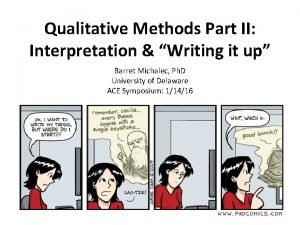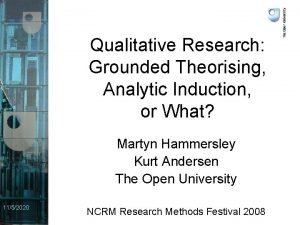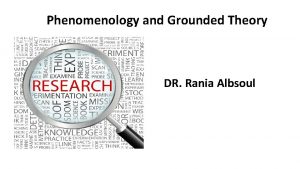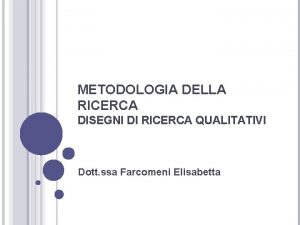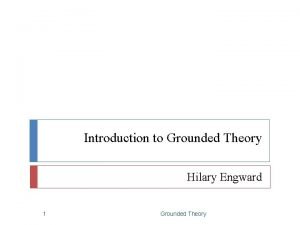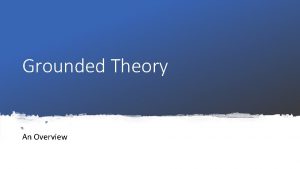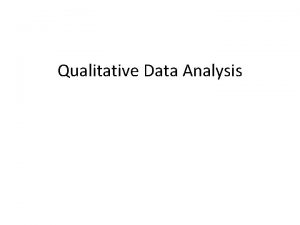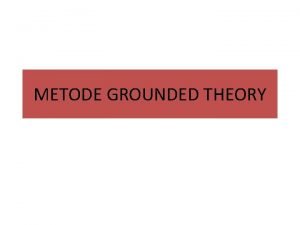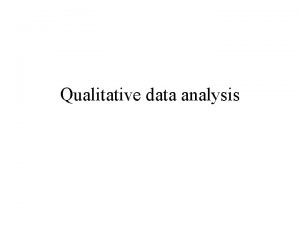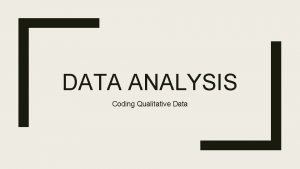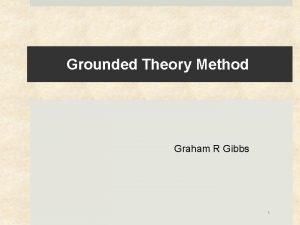Qualitative Data Analysis Grounded theory Grounded theory GT











- Slides: 11

Qualitative Data Analysis Grounded theory

Grounded theory GT is the systematic generation of theory from data could be seen as the opposite to traditional research using scientific method collect data first - relating to general research aims and questions rather than a specific hypothesis

Grounded theory key points in the transcript are marked with a series of codes, extracted from the text codes are then grouped into similar concepts in order to make them more workable. From these concepts, categories are formed, which are the basis for the creation of a theory

Grounded theory GT developed by 2 sociologists, Glaser and Strauss Developed while doing research on dying hospital patients Later the pair disagreed about how to do GT and wrote separately about how it should be used and conducted

Aims of GT to generating concepts that explain people’s actions regardless of time and place; to formulate hypotheses based on the What’s going on here? conceptual ideas; to discover the participants’ main concern and how they continually try to resolve it “to discover theory implicit in the data” (Glaser, 1992) GT does not aim for the "truth" but to conceptualize what's going using empirical data What is the Pps main problem and how are they trying to solve it?

Findings in GT Findings are not facts; they are probability statements about relationships between concepts Validity in GT is assessed using the following: Fit: relates to how closely the concepts fit with the incidents they are representing, how thorough was the comparison of incidents to concepts? Relevance: a relevant study deals with the real concern of participants Workability: The theory works when it explains how the problem is being solved with much variation. Modifiability: A modifiable theory can be altered when new relevant data is compared to existing data A GT is never right or wrong, it just has more or less fit, relevance, workability and modifiability.

Data collection and note taking Barney Glaser. . . warns against tape recording and transcribing says rapport may be lost when data is recorded that transcribing is a waste of time in which more data could be collected Miss Wood says. . . unless you have an excellent memory or are very practiced in taking notes during interviews (which can also lead to loss of rapport) then transcription is fairly commonplace in the collection of qualitative data from interviews!

Coding Stick transcript to A 3 paper: big margins for coding Make notes about the Pp around the top edge Consider each sentence in turn; try to summarise the sentence with a word or phrase; this is now a category or theme Write categories on coloured coded postits and stick round the edge with arrows linking to example quotes Use colour-coding to indicate other quotes which fit your categories/themes You may find that some sentences fit a category but are somehow slightly different; create a sub-category! Biographical notes about the participant

Memoing Use index cards to record any ideas that you have while coding, i. e. about how the issues could be explained or factors which affect the situation and how a people deals with it; how the categories might be related Eventually, you may find one theme /category that arises again and is linked with lots of other categories; this is your core category you will know because it will have high frequency and be highly connected with other categories theory emerges through the memos the coding provides the evidence for that theory

Sorting, sequencing and modelling Having coded all the data; look at the emergent categories and work out what it is that you have discovered and decide how to record this and feedback to the rest of us How? Review your core category, categories, sub categories and arrange them on the desks in a way which shows visually the relationships between categories; aim to create a diagram that illustrates your findings keep moving the post-its around until you feel that you have found the best way to structure your response; Now create a visual depiction of the links between your concepts; use arrows, boxes, bubbles, colour, what ever you need to explain what you have found clearly Example of a grounded theory analysis

Sampling IN GT the sample are also emergent; once you have developed a hierarchy of core category, categories and subcategories, you will want to find out more about mediating factors which affect how these categories are interrelated to do this you may need to survey more people and seek out particular types of people; given the categories that have emerged You might do this through purposive sampling
 Phenomenology
Phenomenology Characteristics of grounded theory
Characteristics of grounded theory Holistic approach in research
Holistic approach in research Qualitative research
Qualitative research Grounded theory qualitative research
Grounded theory qualitative research Grounded theory coding
Grounded theory coding Understanding qualitative research
Understanding qualitative research Analytic induction and grounded theory
Analytic induction and grounded theory Transcendental phenomenology
Transcendental phenomenology Disegno di ricerca qualitativo
Disegno di ricerca qualitativo Features of grounded theory
Features of grounded theory The discovery of grounded theory
The discovery of grounded theory




